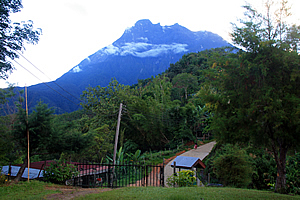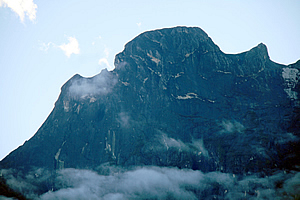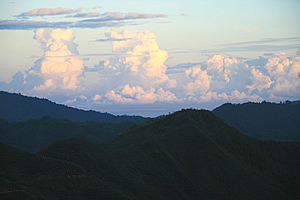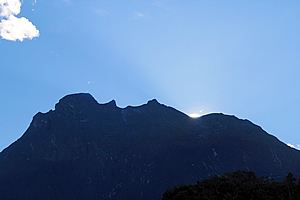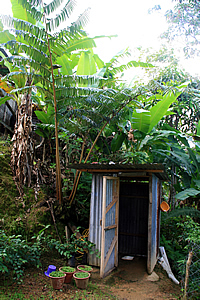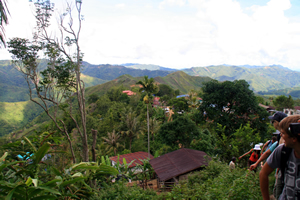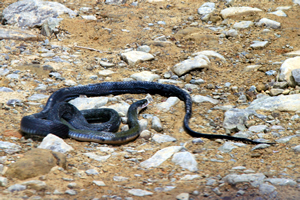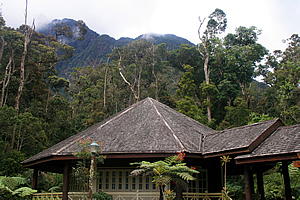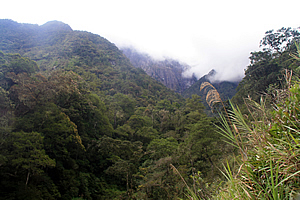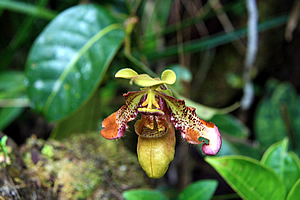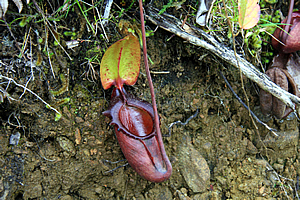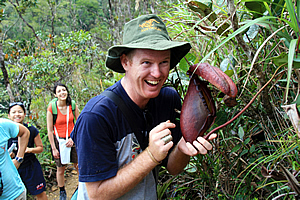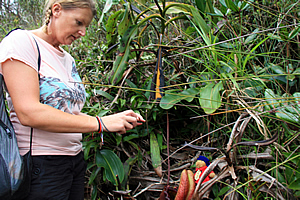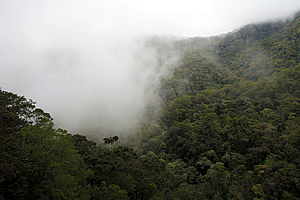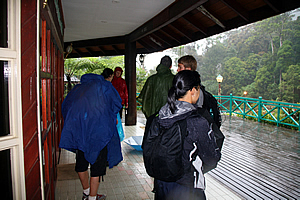|
||||||||||||||||||||||||||||||||||||||
|
||||||||||||||||||||||||||||||||||||||
Home > Treks > Outside Australasia > Mount Kinabalu > 2 |
||||||||||||||||||||||||||||||||||||||
|
||||||||||||||||||||||||||||||||||||||
Introduction to today's journeyThere are some four million different kinds of animals and plants in the world. Four million different solutions to the problems of staying alive. - David Attenborough. Today's journey starts from Kiau Nulu heading around the mountain to the mysterious Mesilau Resort to find some of the world's largest carnivorous plants before heading a short way back around the mountain to a small resort at the start of the trail up the mountain. Today's JourneyDistance trekked today: 2.8 kilometres. Total distance trekked to date: 3.0 kilometres. Today's JourneyIT WAS cold when I awoke the following morning, perhaps because my previous nights in Borneo at sea level had been warm and never dropping below twenty six degrees. Here I was at 1500 metres above sea level, having slept at an altitude higher than I had ever slept before where the temperature would be a good nine degrees cooler. I was the first up in our group, so I quietly dressed and left the hut. The sky above was perfectly clear without a cloud in the sky. The stairs were steep and awkward to climb down, but I made it to the ground level without any dramas. From there I walked through the covered entertainment area to the end of the buildings to see if I could see the mountain.
The view was spectacular. The sun would have already risen well above the horizon, but it was hidden behind the mountain. Although the village was perched at 1500 metres above sea level, the mountain precipitously towered a further 2600 metres above me to stand over four kilometres high. It was a coloured a striking deep purple green, silhouetted strongly against the pale sky. Lingering clouds obscured much of the mountain, but they were swirling around fast enough to afford a complete view after some patience. The mountain stood impossibly steep, the cliff face towered in a precipitous wall to its jagged summits. From here I also had a clear view of the valleys below. The ridges were clear but the valleys were filled with mist. I could see as far as the sea some ninety kilometres away. Over the sea towered puffy storm clouds flecked with the thin horizontal lines of dark nimbostratus clouds. Hopefully they won’t be coming this way anytime soon. Across the valley I could see paddocks on the side of some of the spurs, with small terraces straddling across them where rows of vegetables grew.
I was taken aback by the amazing surroundings. Not only was the view of the mountain and valleys so magnificent, but it terrified me to think that I would be climbing this seemingly impossible purple monstrosity tomorrow. Now I was thinking that perhaps I should have followed through with the decision to retire from mountain climbing after my climb in Hokkaido a couple of years ago. No! Quitting isn't an option. Upon my return from Hokkaido I had immediately bought a set of scales and a fitness DVD and started an exercise program. Within twenty two weeks I had lost fifteen kilogrammes dropping from being borderline obese to reaching my optimum BMI. Additionally I was fitter than ever. Shortly after achieving this I was travelling through Motueka in New Zealand and climbed the nearby 1795 metre high Mount Arthur with ease. Upon reaching the summit I realised there was still hope for me. There and then I officially came out of mountaineering retirement.
Despite that I was saddened that even with my renewed fitness, I would never be able to climb anything higher than the two and a half kilometre high Mount Taranaki. However I started to do some research about places around the world that I wanted to go, and realised in the tropics I could climb mountains far higher than Taranaki. I then realised I could climb mountains even higher than Mount Cook, New Zealand’s highest mountain at 3754 metres. I had stood at the base of Mount Cook before in previous travels, and looking up at its sheer icy slopes I had decided climbing any mountain of that altitude would be totally out of reach. It was therefore a bold move for me when I walked into my travel agency and told them I wanted to climb Mount Kinabalu. At over four kilometres high, it was Borneo’s highest mountain. The thought of scaling such a high mountain was daunting, but I booked a tour that included the climb anyway. This committed me to it, so I joined a personal training class to further work on my fitness. I had a tough challenge ahead of me, but I was committed to stretching my limits and making it happen. Now I was here, and upon seeing this most ominous mountain, I was seriously having second thoughts about my capacity to climb it. Robert and Tobias joined me in marvelling at the mountain. Perhaps they too were also starting to doubt their abilities to climb it. I had by now found out that Robert was just as scared of heights as I am. It seems ridiculous that people like us who struggle to go up a few short steps climbing small ladders would set off climbing mountains over four kilometres high. What drives us to such insanity?
The answer to this would become apparent to me at dawn the day after tomorrow. Until then I just had to grit my teeth and commit to it. By now the cloud had cleared in front of the mountain. I had a clear view of the purple mountain for just a few moments before the sun streamed over the rightmost saddle of the mountain ridge. The rest of the group had joined us by now. The bright sun bursting over the mountain made it a lot harder to see. At least the air was quickly warming up. We returned to the hut to get ready for breakfast, and Richard led us back to the house where we had dinner last night. Obviously the same family was entertaining us for our entire stay. Another family will look after the next tour group who comes after us. A slightly hung over Sapinggi welcomed us into the house. We left our rabble of shoes at the door as we entered the house to once more sit on the floor. The sun flooded through the uncurtained windows harshly illuminating the retro green lino we sat upon.
We ate a hearty breakfast. There was cereal (I assumed bought from a store unlike dinner last night which had been harvested from the hillside farms just yesterday) and fresh boiled eggs. On the way out I saw the outhouse across the other side of the large car port. Beside the outhouse was a giant fern. The fronds were a good four metres long. Richard told me this was a king fern. This is a ground fern with fronds that can grow up to seven metres long. He had attempted to grow one once, but its water demands were just too heavy, and it finally died. He said a friend of his in Melbourne grew one and succeeded because it was at the edge of a permanent pond despite the cool temperate climate there. I made a note of that. This was a magnificent specimen, and its health was testament to the incredibly high rainfall they have here. Once breakfast was finished, Muda, the young fellow who had played guitar last night appeared and took us out on a tour of the village. His English wasn’t very good yet, but clearly he was in training to become a mountain guide, so this village tour would be good practice for him. We were all geared up for hiking, but he wore just a blue muscle shirt, black shorts and thongs, appearing very casual.
We walked up the road past the house where we had dinner and breakfast. We continued walking up the steep gravel road past the several derelict timber houses. They had been built haphazardly out of whatever materials they could find. Their corrugated iron roofs were rusty and the walls were constructed out of all kinds of brick and wooden board. They seemed pretty solid through. Whilst they weren’t perched on the edges of cliffs, the terrain here was quite steep, and the road ran up the ridge towards the mountain, which was now enshrouded in cloud. The steep road suddenly ended above two hundred metres above the house where we had breakfast. Several narrow walking tracks led from the end of the road in all sorts of directions heading further up the slope towards the rest of the village. We followed one of these narrow and muddy tracks which continued steeply uphill. All building materials used to build the houses would have needed to have been taken up these tracks. Low rough fences were used to separate the properties, each having a small block of land where the owners grew their own vegetables. Most gardens were a little untidy and overgrown, but that didn’t matter. They all looked very productive in this very wet climate on the side of the mountain. Despite that, one thing these houses had were amazing views of the five hundred metre drop into the depths of the forested valley below, and across to the next range of mountains rising another five hundred metres to about two thousand metres above sea level. Much of the mountain terrain was forested, apart from the occasional village nestled in the valley and a few paddocks clinging to the mountain slopes.
We continued walking up the difficult track up the steep ridge until we were near the top of the village. We walked through a well landscaped and maintained overgrown vegetable and herb garden to the entrance of a tiny house. The garden looked very productive no doubt due to the very high year round rainfall here. There was also a small muddy pond full of fish to be taken out and cooked when needed to save the long hike down the hill to the river. Near one end of the rectangular pond was a small round mount with a plant growing out of the top. To the right of the entrance of the house was a shed packed full of firewood and gardening gear. An old lady named Dayang appeared at the door balancing her frail body on a walking stick. It was rather surprising someone who struggled to walk would live way up here in this almost inaccessible mountainous place. Dayang had mothered ten children and now lived alone spending her days tending her garden. She had everything she needed, so why not live here? Outside the hut were quite a large number of wooden walking poles. These were all basic metre and a half long sticks with pale purple tape wrapped around one end, but they were all very strong hardwood. Everyone else in the group hired one. I didn’t need to. I had my high tech walking pole with suspension – though regrettably I had not brought it up here with me.
Once done, we continued walking along the narrow track. About ten metres down the track we passed a couple of houses where I saw a small wooden xylophone on the side of the track made from about eight slats of crudely cut wood nailed onto two longer pieces. Muda took the opportunity to once more demonstrate his musicianship by bashing out a very woody tune. It quickly turned and started heading steeply downhill. Now I don’t like walking downhill at the best of times, and this track was steep and muddy – the worst kind of downhill I could imagine at the time. To make matters worse, everyone else now had a walking pole to help them balance. I had nothing. Because everyone else had a walking pole and I was at the front, I was slowing the group down a lot. But somehow we all made it down the muddy hill, over a couple of sties. I was so relieved to be back on the road, although the final walk down the road was still rather too steep. Once more I was doubting my ability to climb the mountain tomorrow. I have watched many documentaries in my time. Some cover unimaginable wonders of the natural world that I would wish to go and see. After all watching a two dimensional screen in the comfort of one's home just doesn't compare with actually being there and experiencing it yourself. Once back at our bunkroom accommodation at Kiau Nulu, we packed up and jumped into the vans. They drove slowly down the steep road. There was a snake coiled on the road in between the two hairpin bends. This would be the only snake I would see in the entire trip across the top of Borneo. It was a mottled greyish green colour with a grey beige underbelly. We continued down the road, crossing the rickety ford at the bottom before climbing up the precariously steep and narrow road on the other side.
It was sheer luxury to be back on the main road again. The road wound its way to the top of the ridge and over the other side from where we had a view of the mountain. By now a lot of cloud had formed obscuring the upper reaches of the mountain, but we still had a good view of the massive dark mountain with spectacular waterfalls tumbling down the forested gullies. We continued the gradual climb until finally reaching the top of a spur back on the other side of the ridge. There was a restaurant here, where we stopped for lunch. I didn’t at this stage know how much further there was to go before we would reach the lodge where we were staying the night. We stopped at the restaurant and got our menus to order food. There was a large whiteboard out the front with a wide range of meals. A large brown moth covered part of the whiteboard, but we could read around it though. We all ordered something, but the restaurant seemed to be almost completely out of food resulting in us having to change our orders a few times. In the end there were only two of the meals they could actually make here. Richard told us that Sapinggi has shares in this restaurant so perhaps he needs to know about this lack of food. During lunch, we discussed what we could do for the afternoon. There was a nice park and botanical garden at the lodge, but Richard started to mention the botanical wonders of Mesilau. This was where David Attenborough had filmed a sequence with the world’s largest carnivorous plants. That was the kind of place I absolutely had to go. I told the group that I was only one person, but if everyone else wanted to go, I’d be keen. Amazingly enough everyone else wanted to come. I was lucky perhaps to be travelling with a bunch of plant enthusiasts. Once lunch was finished, we continued along the road. I had assumed it was still a long way to the park entrance, but it was only two hundred metres up the road. We passed some very tall tree ferns growing along the side of the road and passed under a gate with a steep roof reminiscent of something you would expect when you have the cross between Cambodian and Norwegian architecture. Once under the gate, we turned off the main road to the left and crossed under another big gate with a similar steep roof overhead. We turned into a car park beside a similarly shaped information centre made from reddish brown timber. This too looked like a cross between what you would find in Norway and Cambodia with the steep roofing on two levels and the roofing of the gables pointing outwards. It had a sign over the main door saying “Sutera Sanctuary Lodges”. Concrete steps in between the beds of tall pale purple flowers led up to the centre. It was a very quaint setting. After a bit of mucking around at the information centre, we were cleared to drive off through the cloud forest jungle along the narrow sealed road for about a kilometre until we saw the lodge dropping off down the hill to our right. We climbed out of the van and walked down the concrete stairway. It was rather precarious as it had partially collapsed down the slope of the hill and leaning over at about fifteen degrees. We all got down safely though and found our bunk rooms. I had a shared bunkroom with Geoff, Casper and Tobias. I took a bottom bunk and put my gear there before packing up for the short trip to Mesilau. The sky was overcast and drizzle was falling when we left the lodge. We drove back out of the park at the information centre and turned left down the main road. The road descended gradually as the valley widened. There was no forest down here because it had been cleared for agriculture. We eventually reached a small town flowing over a ridge. Dilapidated shops lined the right hand side of the main road, and the left hand side had been cleared for some future development. We turned left following a road going through the development to cross the bottom of the valley passing a sugar cane field. The bamboo framework of a large building was being built in behind the field. The road then started to climb uphill passing the small farms. The road became steeper and more rugged as we gained altitude. The rain had by now stopped falling, but we were soon high enough to be enveloped by the thick cloud. The vegetation now looked eerie in the thick fog that clung to the mountainside. We were now alternating between farmland on the ridges, and thick forest that seemed strangely familiar in the gullies.
The road steepened as we continued to climb, but we quickly got above the layer of cloud. It was still overcast with a thick layer of cloud above us, but at least it was clear up here in between the cloud layers. The farmland quickly gave way to thick cloud forest. Then we saw the sign – Mesilau Resort. Now this didn’t seem like most resorts I had seen to date. Most resorts are beach resorts. This was a cloud resort. It didn’t have the frenetic activity and crowds that usually come with the beach resorts. This one seemed very quiet. Although we couldn’t see into it, there were no people around. We continued for another hundred metres past the resort before turning a corner and seeing the octagonal shaped Mesilau Nature Centre ahead of us made of red stained timber and tiling that colour matched the tiling on the smaller octagonal building to the right. A covered walkway joined them. The setting could very well have been taken straight out of New Zealand, perhaps in Fiordland. The nature centre was coloured khaki green and had thatched roofing. The surrounding forest had huge trees very closely reminiscent of the Red Beech forest in New Zealand and numerous tree ferns in front with a few very traditional looking streetlights in front of the tree ferns. More tree ferns surrounded the buildings. Behind the forest were some rounded summits of a few hills enshrouded in the next layer of patchy cloud, and towering above them was the precipitous granite Mesilau Peak, one of the lower peaks of Mount Kinabalu. The car park had a few cars parked in it, but there were no people around. They must all be out hiking. I saw a sign pointing to the start of the Mesilau route to Mount Kinabalu – the long way up. The track started as a concrete path with lamp post bollards heading into the forest. I’m sure the standard of the track would deteriorate quickly though. We entered the information centre and Richard organised our entrance to the side track that would take us up to the largest carnivorous plants in the world.
The air was suddenly cold and humid indicating heavy rain was near. Fortunately we all had good raincoats. We began the walk up a dark thickly forested gully. A rushing stream cascaded unseen to our right. The track followed above the river upstream for a few minutes before suddenly dropping down the bank to a swing bridge. This marked the start of a side track steeply ascending the other side of the deep valley. The main track continued following the stream. We turned off and crossed the swing bridge, crossing the small cascading stream negotiating its way around the huge granite boulders brought down by floods past. Once across the stream we started climbing a set of stairs constructed from wood into what is known as the Nepenthes Garden. We very quickly rose above the forest and climbed up through the grassy scrubland. About two minutes later, Richard pointed out a couple of small nepenthes plants. These were as big as my biggest ones at home. They were quite impressive sitting there on the swampy ground in their natural environment.
The steep path now passed through low forest of gnarled moss covered trees. These had orchids growing on them. Ethereal peels of thunder boomed through the clouds, echoing between the steep sides of the valley. We quickly ascended along the track cut into the orange granite, passing numerous huge nepenthes plants. The swing bridge and stream were now a far below us. The nature centre and road were completely hidden from view behind the sharp ridges on the other side of the stream. It was very rugged and wild up here. The ground was a little soft and swampy. It was just like the swamps you see in Australasia, but the land here was sloping at over forty five degrees. I had never seen a vertical swamp like this before.
In amongst the shrubs, we saw a slipper orchid, camouflaged against the other vegetation. The flowers were coloured yellow green with small reddish brown spots towards the outer ends of the petals. The flower looked strikingly similar to a pitcher – or should I say the pitchers on the pitcher plants looked strikingly like the local orchids to attract the insects that would be tricked into thinking they were pollinating an orchid but would instead fall into the pitcher trap to drown and be dissolved by the enzymes. Then we saw one plant containing bright purple red pitchers with capacity of about a litre. This was the legendary Nepenthes Raja – the king of the pitcher plants. This was the largest species, and considered to be the holy grail of carnivorous plants.
The track levelled off as we passed a few more giant specimens. Then the track sloped steeply downhill. Now I had to go downhill, which I hated with a passion. The track doubled back on itself. Then we suddenly stopped and Richard pointed out an absolute mammoth of a plant. The pitchers on this plant were two litres each. Each pitcher was coloured a deep blood red with a lid pale green underneath and patchy red and green on top over its two humps. The lids were designed to keep the rain out of the pitchers, but most of the heavy pitchers were sitting at such an angle as to be leaning over. This was the very plant that David Attenborough had once done a segment on plant carnivory. I was truly honoured to be at this magnificent specimen and to have followed in his footsteps. David Attenborough has always been my favourite television presenter. His Life on Earth series in the early eighties had inspired me to learn natural history. The way he presents things is so amazing. Now here I was at one of his favourite spots.
Therese posed her Paddington Bear inside one of the cups. That can’t have been too healthy. Someone asked Richard if it were safe enough to drink from the cups. No way, he said. The water contains dangerous enzymes that form a perfect symbiotic relationship with the plant. He said that he came up here once and saw a huge rat that had been caught in a cup that day. It had climbed into it to drink the water, but had fallen in and drowned. Just two days later there was nothing left apart from a segment of the tail that had been hanging out of the cup. The rest of the rat had completely dissolved making a very nice meal for the plant. Those enzymes must be very dangerous. There were several other Nepenthes Raja specimens here, and one of those was in flower. It was a male plant as each plant is a different gender only able to produce either male or female flowers.
Cloud poured up the valley, and another clap of thunder struck. This time it was close by. We looked at a few surrounding huge plants before rain started to fall. We quickly pulled out our rain coats and started walking back quickly. The rain quickly became heavy as we walked back. I was at the back of the group and struggled a bit with the long steep downhill. Everyone else seemed to be going at a very good pace, but I was staggering along at the end. If I was struggling with this now, how on earth will I be able to cope when I am coming down the mountain in two days’ time? I was relieved upon finally reaching the swing bridge. The rain was pouring down to the extent the sound was mixing in with the sound of the torrent of water below me. Richard was waiting for me at the other side of the swing bridge, and we walked back through the dark forest to meet the others back at the verandah of the nature centre. The thick cloud made it dark enough for the lamps to be turned on now.
We were all in our rain coats looking soaked, but we were all fortunately quite dry having only been out in the torrential rain for a short length of time. We took them off and went into the information centre to look at all the nepenthes displays, and other displays of all the different animals around the area. There were displays of rhododendrons, rafflesia, and all sorts of other strange plants that grow in this amazingly bio diverse area. We then returned outside, and once the rain cleared, returned to the van and headed back down the mountain and around back to the lodge where we were staying. |
||||||||||||||||||||||||||||||||||||||
|
||||||||||||||||||||||||||||||||||||||

